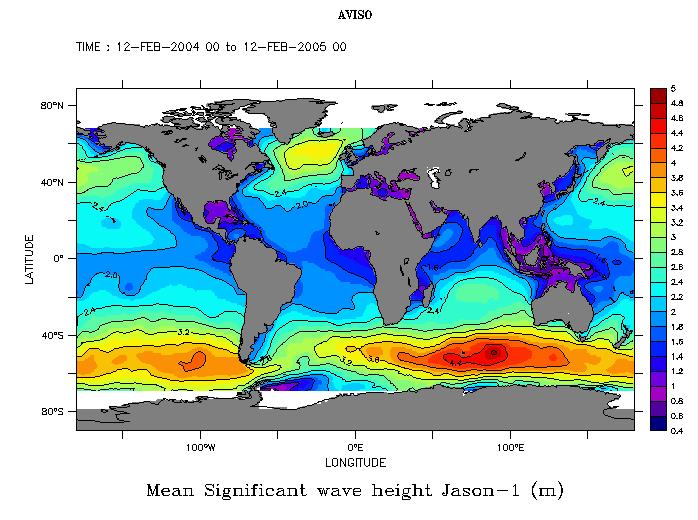Sea State

Map of Wave Height
Figure: Annual Mean significant wave height in m, measured by the Jason-1 Satellite. Source: https://www.aviso.altimetry.fr/en/data/data-access/las-live-access-serv…. |
ECV Products and Requirements
These products and requirements reflect the Implementation Plan 2022 (GCOS-244).
The requirements are found in the complete 2022 ECVs Requirements document as well: ECV Sea State.
| Products | Wave Height | ||
| (*) | Unit | Values | |
| Horizontal Resolution | G | km | 1 |
| B | 25 | ||
| T | 100 | ||
| Vertical Resolution | G | - | |
| B | - | ||
| T | - | ||
| Temporal Resolution | G | h | 1 |
| B | 3 | ||
| T | 24 | ||
| Timeliness | G | d | 7 |
| B | 30 | ||
| T | 365 | ||
| Required Measurement Uncertainty (2-sigma) | G | % | 5 |
| B | |||
| T | |||
| Stability | G | cm/ decade | 1 |
| B | |||
| T | 10 | ||
(*) Goal (G): an ideal requirement above which further improvements are not necessary. Breakthrough (B): an intermediate level between threshold and goal which, if achieved, would result in a significant improvement for the targeted application. The breakthrough value may also indicate the level at which specified uses within climate monitoring become possible. It may be appropriate to have different breakthrough values for different uses. Threshold (T): the minimum requirement to be met to ensure that data are useful
Data sources
This list provides sources for openly accessible data sets with worldwide coverage for which metadata is available. It is curated by the respective GCOS ECV Steward(s). The list does not claim to be complete. Anyone with a suitable dataset who wishes it to be added to this list should contact the GCOS Secretariat.



